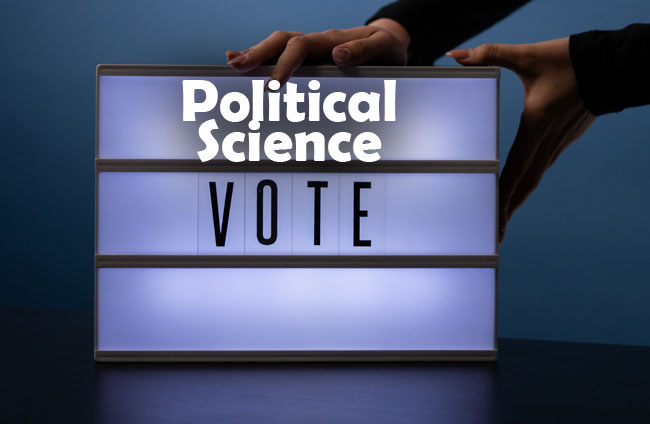Political Science Model Question
Latest Political Science Model Question are available here. So, the candidates who are searching can refer the Political Science Model Question for better preparation. View the free download links of Political Science Model Question Papers in the below section.

Political Science Objective Model Question are available here to download for free. Aspirants can download Political Science Model Question Solved Papers from our website. We have updated the Political Science Model Question which helps the candidates who are appearing for the competitive exam.
Model Question on Political Science
1. The historic ‘Quit India’ resolution was passed under Mahatma Gandhi’s leadership at Gowalia Tank median in the city of:
(A) Kolkata
(B) Chennai
(C) Lucknow
(D) Mumbai
2. Who was the revolutionary Marxist leader with whom M.N. Roy had a prolonged political debate in 1919-1920?
(A) Karl Marx
(B) V.I. Lenin
(C) Joseph Stalin
(D) Mao Tse Tung
3. Who among the following personalities established the organisation ‘Abhinav Bharat’?
(A) B.G. Tilak
(B) M.K. Gandhi
(C) Rabindranath Tagore
(D) V.D. Savarkar
4. Which of the following were the tenents of Jayprakash Narayan’s concept of Communitarian Democracy?
(a) Decentralised political economy
(b) Competitiveness
(c) Deliberate process of devolution
(d) Harmonization of interest
Choose the answer from the following codes:
(A) (b), (c), (d)
(B) (a), (b), (c)
(C) (a), (c), (d)
(D) (a), (b), (d)
5. Which one of the following is not separatist movement?
(A) JKLF
(B) ULFA
(C) PLA
(D) Naxalism
6. Who among the following launched Kalaram Mandir Entry Satyagraha?
(A) Mahatma Gandhi
(B) Vinoba Bhave
(C) Dr. B.R. Ambedkar
(D) J.P. Narayan
7. Which one of the following is the characteristic of post-behaviourism?
(A) Quantification
(B) Relevance
(C) Value free
(D) Pure science
8. With which of the following organizations Periyar E.V. Ramsamy was associated?
(a) Self-Respect Movement
(b) Justice Party
(c) Dravidar Kazhagam
(d) Home-rule Movement
Choose your answer from the following codes:
Codes:
(A) (a), (c), (d)
(B) (b), (c), (d)
(C) (a), (b), (c)
(D) (a), (b), (d)
9. Agganna Sutta is in which text?
(A) Digha Nikaya
(B) Tripitika
(C) Vinaya Pitaka
(D) Dhammapada
10. In Buddhist literature what is ‘Sutta’?
(A) Dialogue between Buddha and Sanjaya
(B) Discourse imparted by the Buddha to two Brahmins: Bharadvaja and Vasistha
(C) Dialogue between Sariputta and Assaji
(D) Discourse between Anuruddha and Katyayana
11. Which imperialist country had maximum number of colonies?
(A) Great Britain
(B) France
(C) Portugal
(D) Holland
12. Which leader of anti-colonial struggle served as President of Zambia from 1964 to 1991?
(A) Kenneth Kaunda
(B) Harry Nkumbula
(C) Julius Nyerere
(D) Robert Mugabe
13. Who among the following leaders was not associated with anti-colonial struggle?
(A) Mahatma Gandhi
(B) Kenneth Kaunda
(C) Harry Nkumbula
(D) Daniel Lisulo
14. Identify the non-democratic regimes from the following:
(A) Switzerland
(B) Australia
(C) Cuba
(D) Denmark
15. In which of the following developing countries transition from democracy to consolidated democracy can be witnessed?
(A) Kenya
(B) India
(C) Uruguway
(D) Pakistan
16. Choose the incorrect statement:
(A) New social movements focus on issues related to human rights.
(B) Gay rights movement can be considered as new social movement.
(C) New social movement emerged in mid 1960 i.e. in a postindustrial economy.
(D) Animal rights movement cannot be called new social movement as it is not related to human rights.
17. Which among the following is not new social movements?
(A) Women’s movement
(B) Ecology movement
(C) Gay rights movements
(D) Peasant movement
18. Which of the following political systems has multiparty system?
(A) USA
(B) Great Britain
(C) France
(D) Australia
19. Which is not the feature of Schumpeter’s elite model of participatory democracy?
(A) Common people do not have capacity to make intelligent decisions in area of politics.
(B) In democracy the actual power is in the hands of an elite minority.
(C) Democracy is competition between elites and masses.
(D) In democracy the role of citizens duty begins and ends with selecting — via ballot box — the individual or party.
20. …………………………… Committee was appointed for advising the Government about Non-Scheduled Languages.
(A) Chandrashekhar Kambar
(B) Bhalachandra Nemade
(C) Sitakant Mahapatra
(D) Ashok Vajpayee
| Test Papers | Model Question |
| Important Question | Previous Papers |
| Practice Set | Quiz |
| Mock Test | GK |
| Sample Question | MCQ |
21. …………………………. accord was an attempt to contain terrorism in Punjab.
(A) Rajiv — Longowal
(B) Indira Gandhi — Bhindranwale
(C) Nehru — Laldenga
(D) Vajpayee — Badal
22. Who led the All Assam Students’ Movement against migration?
(A) Prafulla Mahanta
(B) Hiteshwar Saikia
(C) Gopinath Bardoloi
(D) Tarun Gogoi
23. Frequent use or misuse of Article …………………… has caused rift in Centre-State Relations.
(A) 352
(B) 360
(C) 356
(D) 32
24. Which of the following is not correct?
(A) Demolition of Babri Masjid — 1992
(B) Announcement of LPG Policy — 1991
(C) RTI Act — 2005
(D) Assassination of Indira Gandhi — 1985
25. Reorganisation of states was done on the recommendations of …………………. Commission.
(A) Fazal Ali
(B) Dar
(C) Sarkaria
(D) Mandal
26. Which of the following is not a Dravidian Political Party?
(A) Dravida Kazhagam
(B) Marumalarchi Dravida Munnetra Kazhagam
(C) Telangana Rashtra Samiti
(D) All India Anna Dravida Munnetra Kazhagam
27. Which of the following castes is not mobilised recently for seeking reservation?
(A) Jats
(B) Patidars
(C) Marathas
(D) Malis
28. …………………………. is the new entrant in the voting process in India.
(A) Ballot Paper
(B) EVMs
(C) VVPATs
(D) Electoral Violence
29. The leader of the opposition in the 16th Lok Sabha was:
(A) Kamal Nath
(B) Mallikarjun Kharge
(C) Rahul Gandhi
(D) Gulam Nabi Azad
30. Which of the following is not a Union Territory?
(A) Mizoram
(B) Lakshadweep
(C) Andaman & Nicobar Islands
(D) Daman & Diu
31. Article 1 of the Indian Constitution describes India as the:
(A) Territories of the States
(B) Union of State
(C) Indian Federation
(D) Confederation
32. The Joint Session of the Parliament is chaired by the:
(A) Speaker of Lok Sabha
(B) Vice-President of India
(C) Chairman of the Rajya Sabha
(D) Prime Minister of India
33. The President of India addresses both the Houses of Parliament assembled together:
(A) During the emergency session of the Parliament
(B) Every Session
(C) First Session after each General Election and First Session each year
(D) Any Session
34. Supremacy of the Constitution means:
(A) Constitution is above States
(B) Constitution is above Government
(C) Constitution is above all institutions, organisations and citizens
(D) Constitution is above the Parliament
35. Which of the following is the largest Committee of the Parliament?
(A) The Estimates Committee
(B) The Public Accounts Committee
(C) Committee on Public Sector Enterprises
(D) The Committee on Petitions
36. The Council of Ministers hold office:
(A) During the pleasure of the President
(B) During the pleasure of the Speaker
(C) For a fixed term of five years
(D) During the pleasure of Prime Minister
37. The following word was added to the Preamble by the 42nd Amendment:
(A) Secular
(B) Democratic
(C) Republic
(D) Sovereign
38. According to the Constitution, the President of India works on the aid and advice of:
(A) The Vice-President
(B) The Prime Minister and the Council of Ministers
(C) The Supreme Court of India
(D) The Attorney General of India
39. Which Article of the Constitution envisages a Supreme Court?
(A) 128
(B) 124
(C) 132
(D) 136
40. One of the key features of development administration is that it:
(A) Emphasizes on regulatory work
(B) Emphasizes on rule-bound conduct
(C) Emphasizes on centralization
(D) Emphasizes on participation
41. The New Public Administration advocated:
(A) Management science approach
(B) Efficiency and economy
(C) Social relevance based approach
(D) Value neutrality
42. The Minnowbrook Perspective and Frank Marini are associated with the emergence of:
(A) New Public Administration
(B) Development Administration
(C) Scientific Management
(D) Rational Choice Theory
43. Which one of the following subfields emphasized on values and ethics?
(A) Comparative Public Administration
(B) New Public Management
(C) New Public Administration
(D) Rational Choice Theory
44. Which one of the following actions is indicative of ‘integral’ dimension in the working of an organization?
(A) Filing papers
(B) Planning
(C) Staffing
(D) Coordinating
45. Give the correct answer by using the correct code given below:
Assertion (A): Some scholars have ridiculed and rejected the principles of administration as “myths” and “proverbs”.
Reason (R): For almost every principle, one can find an equally plausible and acceptable contradictory principles.
Codes:
(A) Both (A) and (R) are true and (R) is the correct explanation of (A)
(B) Both (A) and (R) are true but (R) is not the correct explanation of (A)
(C) (A) is true but (R) is false
(D) (A) is false but (R) is true
46. Accountability as one of the three cardinal principles of Public Administration is ensured in New Public Management by:
(A) Performing agency’s goods
(B) Following procedures in totality
(C) Not obeying orders of superiors
(D) Preventing misuse of public money
47. Max Weber identified it as essential feature of modern bureaucracy:
(A) Hierarchy
(B) Flexibility of rules
(C) Patronage
(D) Personal charisma
48. The principle that “a subordinate employee should receive orders from one superior only” is known as:
(A) Span of Control
(B) Unity of Command
(C) Hierarchy
(D) Delegation
49. Which one of the following is not a characteristic of new local governance?
(A) Organised on formal and legal pattern
(B) Based on the post-bureaucratic notion of organisation
(C) Operate through open networks
(D) Participation of stakeholders in decision-making process
50. Functions discharged by the Panchayat Raj Institutions fall under:
(A) the 9th schedule
(B) the 10th schedule
(C) the 11th schedule
(D) the 12th schedule

